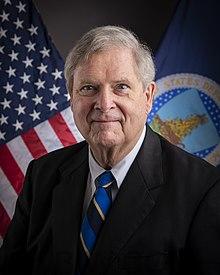
WASHINGTON – The U.S. Department of Agriculture (USDA) and the U.S. Department of Energy (DOE) are launching a new initiative to help farmers cut costs and increase income using underutilized renewable technologies and smaller-scale wind projects.
Through the Rural and Agricultural Income & Savings from Renewable Energy (RAISE) initiative, USDA is setting an initial goal of helping 400 individual farmers deploy smaller-scale wind projects using USDA’s Rural Energy for America Program (REAP).
This goal is only possible because President Biden’s Inflation Reduction Act provides more than $144 million in grant funding for underutilized technologies through the REAP program.
DOE is announcing a total of $4 million in related funding, including $2.5 million to support the testing, certification, and commercialization of the latest distributed wind technologies for the agricultural sector and $1.5 million to support outreach and the identification and development of new business models for farmers to save money and earn income deploying these technologies.

“Today’s announcement furthers the Biden-Harris Administration’s commitment to rebuild our nation’s economy from the middle out and bottom up by increasing income and opportunities for the small and mid-sized farmers that keep rural main streets vibrant,” USDA Secretary Tom Vilsack said. “By strengthening our longstanding partnership with DOE through the RAISE initiative, USDA is ensuring farmers and hardworking Americans everywhere have the opportunity to save money and earn income from smaller-scale, distributed renewable energy technologies. These investments will create long-lasting economic benefits for their families, businesses, and communities for years to come.”

“There is a huge opportunity to power the American heartland with distributed wind resources, and President Biden’s Investing in America agenda is tapping into that potential so that all Americans can reap the benefits of the clean transition,” said U.S. Secretary of Energy Jennifer M. Granholm. “DOE is raising the bar with our partners at USDA—creating jobs, lowering costs, and increasing energy independence for farmers and those in rural communities.”
Operating under an existing memorandum of understanding, USDA and DOE have a joint working group overseeing an action plan for the RAISE initiative. DOE has identified advances in certified distributed wind technology that have opened a significant market opportunity, enabling cost-effective investments for farmers and rural communities.
Initial RAISE initiative activities, focused on smaller-scale or distributed wind, are expected to include:
- USDA providing additional technical assistance to support applications for the use of the $144.75 million in grant funding from the Inflation Reduction Act for REAP underutilized technology projects, including but not limited to farmer-owned smaller-scale wind projects, small-scale hydropower, geothermal, biomass-based and other clean energy. The DOE also intends to prioritize technical assistance for smaller-scale wind projects.
- DOE’s Wind Energy Technologies Office is funding $1.5 million for research into and outreach on new business models for farmers’ collaborations to earn income from distributed wind, including through farm associations that could administer it with fee-for-service models.
- DOE’s Wind Energy Technologies Office is calling for proposals for up to $2.5 million under the Distributed Wind Competitiveness Improvement Project (CIP), which funds distributed wind technology development, testing, certification, and commercialization. CIP supports U.S. component suppliers and small- and medium-sized wind turbine manufacturers. For the first time, this round of CIP funding specifically focuses on commercializing distributed wind turbines for the agricultural sector in support of the RAISE initiative.
- USDA and DOE are hosting a joint webinar series to inform farmers, rural electric cooperatives, farm associations, and small-scale, distributed wind providers about our programs and how to use them to develop place-based wind projects. The first webinar in the series will launch a new National Distributed Wind Network and Resource Hub on March 14, 2024.
- USDA and DOE are developing a farmer’s guide to distributed wind power including technical, economic, and geospatial analysis regarding distributed wind technologies and applications and ways to finance smaller-scale wind projects.
Background:
There are many small-scale, underutilized technologies that farmers and rural communities can benefit from. USDA and DOE are working together through the RAISE initiative to increase education, outreach, research, and technical assistance to help small and mid-sized farmers save money and earn income from underutilized technologies.
Distributed wind includes, for example, a single wind turbine to meet a farm’s energy demand and save and stabilize electricity costs. It could also include a few wind turbines across several farms to support a local electricity utility, thereby earning a revenue stream for the hosting farms.
Distributed clean energy projects can create cost savings and income for farmers and rural small businesses. They also support energy independence and local electric grid reliability and enhance resilience by providing backup power, especially when paired with energy storage. These projects also create jobs and investments in rural economies, with approximately a third of a renewable energy project value usually invested in the local communities through construction jobs and maintenance. These projects also allow farmers, rural electric coops, and food companies to address climate change.
DOE has worked with industry partners and its national labs to develop a new generation of reliable, high-performing, cost-effective distributed wind technologies certified to national performance standards and representing significant improvements over prior generations of distributed wind technology.
DOE ensures America’s security and prosperity by addressing its energy, environmental, and nuclear challenges through transformative science and technology solutions. Learn more about DOE’s efforts to advance distributed wind and sign up for the Wind Energy Technologies Office’s newsletter.
USDA Rural Development provides loans and grants to help expand economic opportunities, create jobs, and improve the quality of life for millions of Americans in rural areas. This assistance supports infrastructure improvements, business development, housing, community facilities such as schools, public safety, and health care, and high-speed internet access in rural, tribal, and high-poverty areas. Visit the Rural Data Gateway to learn how and where these investments impact rural America. To subscribe to USDA Rural Development updates, visit the GovDelivery Subscriber Page.
USDA touches the lives of all Americans daily in so many positive ways. To learn more, visit www.usda.gov.



